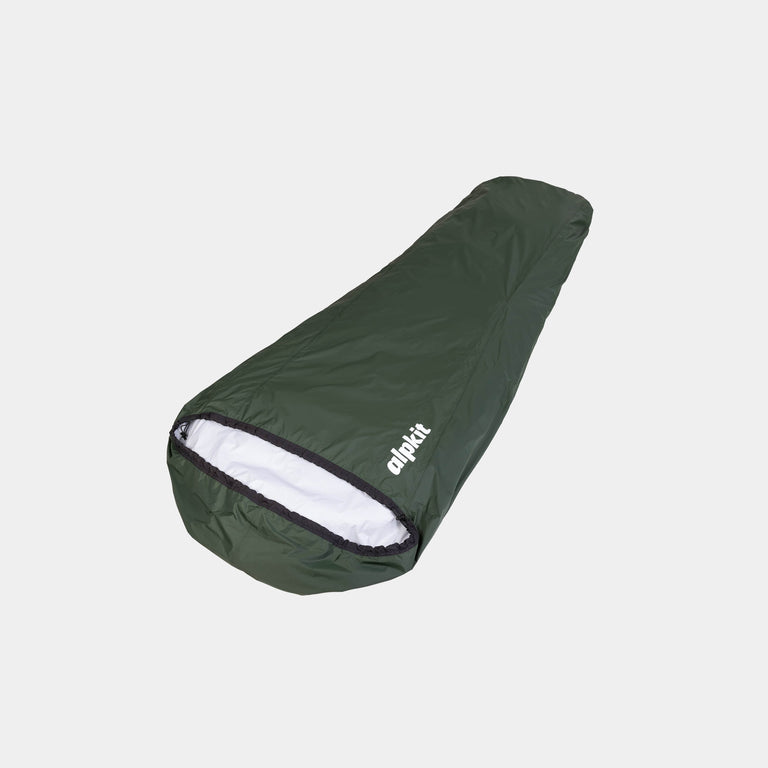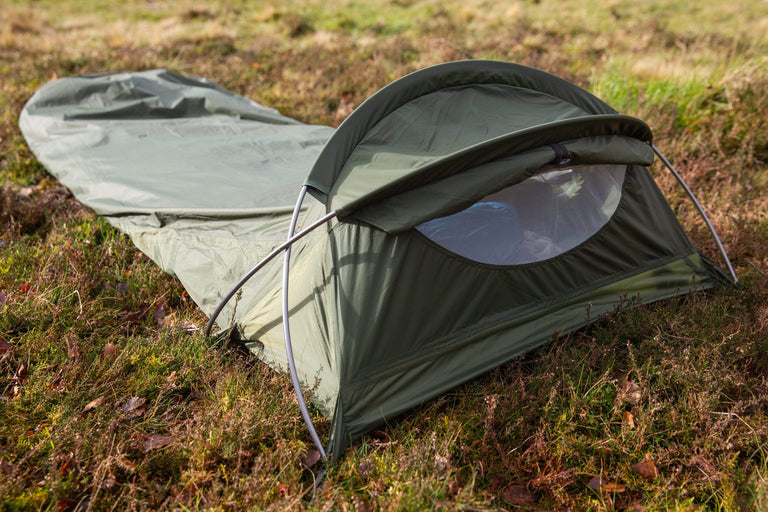
Discover the simplicity and freedom of bivvying. This guide covers everything you need to camp light, stay dry, and connect with nature.
Bivvying is camping in its simplest form - lightweight with minimalist gear. It's camping without a tent. Bivvying extends the range of adventures whether you backpack, go by bike or a local overnight trip. But before we go over all that, let's start with some basics.
Everything you need to know about bivvying
- What is a bivvy bag?
- What's the difference between a bivvy bag and a sleeping bag?
- Why use a bivvy bag instead of a tent?
- Are bivvy bags waterproof?
- Do bivvy bags keep you warm?
- How do you stop condensation in a bivvy bag?
- How do you use a tarp with a bivvy bag?
- Do you need to use a groundsheet with a bivvy bag?
- How to go bivvying in summer
- How to go bivvying in the winter
- Bivvy bags are ideal for MicroAdventures
- Where can you bivvy?
- What kit should I take when I'm bivvying?
- Find out more about bivvying

What Is A Bivvy Bag?
Bivvy bags are a little like a waterproof jacket for your sleeping bag. They enable us to sleep as close to nature as possible while maintaining some protection from the elements.
Though any kind of waterproof cover would theoretically work, like any waterproof jacket, they need to have a good level of breathability so you don't get a build-up of condensation. No one wants to wake up to a soggy sleeping bag.
What's the difference between a bivvy and a sleeping bag?
Bivvy bags are like waterproof jackets for your sleeping bags. Your sleeping bag is the insulation designed to keep you warm. Your bivvy bag is to keep your sleeping bag dry. A dry sleeping bag is a warm sleeping bag. Though they keep rain and wind off, bivvy bags are not specifically designed with warmth in mind.

When should I choose a bivvy bag instead of a tent?
For weight conscious fastpackers, a bivvy bag is the lightest and tiniest of transportable homes. Our ultra-lightweight Kloke bivvy bag is just 285g. That’s about as heavy as your average pomegranate. And our winter-ready Hunka XL weighs just 500g.
On technical, awkward terrain, a bivvy opens up a world of sleeping opportunities. Tucked into a cranny on a scramble or snuggled into a nook of a cave, bivvies fit where tents can’t.
And for minimalist midweek micro-adventures, a bivvy offers full immersion in the huge, dark sky. You can stargaze until you sleep, feel the elements and wake up with the sunrise.
You have the mountains to yourself, and there's nothing quite like waking up to an autumnal sunrise. The colour of the sun mimics those of the trees. The reds, the oranges, the yellows. Whipping up a cup of tea from inside your warm and cosy sleeping back while listening to the birds wake up around you sets the mood for the day ahead (another reason we love a mid-week bivvy). What's not to love?
Are bivvy bags waterproof?
Yes. For example, our Hunka bivvy bag is made from a waterproof, breathable and now 100% recycled material with fully taped seams. It has a hydrostatic head rating of 10,000mm – the British Standard to define “waterproof” is 1,500mm. We have more tips in our blog post How to bivvy in the rain and stay dry.
Do bivvy bags keep you warm?
Bivvy bags are not insulated like a sleeping bag. However as they are windproof and waterproof they will help prevent heatloss through windchill and evaporation. For this reason they are often carried as an emergency shelter.

How do you stop condensation in a bivvy bag?
Breathing and sweating are bodily functions that produce moisture that condenses in our sleeping bags, making us feel clammy and cooling us down.
In summer, we sweat. You might get into your bivvy bag feeling cold, but you will naturally warm up throughout the night. Try to avoid overheating by not overdressing before turning in for the night.
To prevent condensation – and ultimately cooling down - from breathing through the night, make sure to breathe outside your bivvy bag. Wear a woolly hat to keep your noggin toast.
How do you use a tarp with your bivvy bag?
Tarps are useful in windy, rainy conditions. A carefully erected tarp can be the difference between a restless sleep and a peaceful one. They’re a lightweight addition to your shelter set up. To help you get started we have written a handy guide with six common ways of setting up your tarp.
Do I need a groundsheet with my bivvy bag?
In wetter, colder conditions, you can lose up to 30% of your body heat through the ground. A groundsheet combined with a sleeping mat gives an extra layer of protection against the damp and cold of the ground.

Long days, stary nights and summer bivvying
Summer is a rewarding time of the year to experience your first bivvy adventure. The weather is generally milder and more predictable in the summer, making bivvying a more pleasant experience. Bivvying can bring you closer to nature, as you'll sleep outdoors with minimal barriers between you and your surroundings. Sleeping in a bivvy bag on a clear summer night offers a fantastic opportunity for star gazing that you wouldn't get with a tent. We have put together a lightweight summer bivvying kit list to get you started.
How to go bivvying in the winter
Heading out for a winter bivvy may seem a little off the walls to some, but we've found that those who try it once usually end up going back for more! We have put together a guide to winter bivvying with specific information about the best equipment to take.

Bivvy bags are ideal for Micro Adventures
If you are limited in time or have to stay close to home, a Micro Adventure might be for you. Alpkiteer Al Humphreys has been using our Hunka bivvy bags on his micro-adventures for years. Create your own backyard bivvy or find inspiration for your adventure close to home in this Micro Adventure webinar featuring adventure junkies Alastair Humphreys, Emma Kingston and Sarah Leighton.
Where Can You Bivvy?
Though wild camping isn't actually legal in England and Wales, as long as your are kind and considerate by setting camp after dark and getting up soon after light then you're unlikely to come into any hassle if you choose the right bivvy spot.
Be mindful of where you decide to stay, head a good few metres away from the trail so you stay out of anyone's way, and as always, when you're heading outdoors, follow a strict leave no trace policy so no-one can tell you were even there in the first place. Like a bivvying ninja.
What should you take on a bivvy - a bivvying kit list
Every bivvy adventure is different and depending on where in the world you are and what time of year it is, the exact kit might vary slightly. We've thrown together a list of essentials that we always keep on hand for those last-minute getaways.
1 - Bivvy Bag
Although not necessarily essential for sleeping out in the open, it's worth having one to keep you dry. Tall folk will usually have no choice but to use a large bivvy bag (like the Hunka XL). Less tall folk have a little more choice: you could go for a regular sized Hunka, or buy a larger bivvy bag and put your sleeping mat and kit inside. It's all down to personal preference. If you want to go ultralight and pack small, you could also try the lightweight Kloke.
Generally speaking, bivvy bags offer 'unstructured' shelter, but inevitably, there is always one which bucks the trend. Our bivvy bag">Elan hooped bivvy bag takes the best qualities of bivvy bags and adds a small hoop over your head.
2 - Cooking system
An essential for midweek and weekend bivvies alike! Bivviers after lighter loads would usually opt for a minimalist system like the Kraku and MytiMug, whereas those who are after a super quick brew would prefer an integrated system like the Brukit. Either way, you need something to eat with chopsticks might look fancier when you're eating your noodles, but we recommend something a little more versatile when it comes to cutlery, such as the Tifoon.

3 - Tarp
When it's not the rain, it's the wind. Tarps aren't strictly necessary for sleeping out in the open, but you won't regret having one when the weather comes in.
We recommend opting for a tarp with a plethora of attachment points, including risers, for ease of use and a wider range of configurations. The Rig 7 is our favourite, as you can fit a friend under it too! But the Rig 3.5 is the solution for solo sleepouts.
See our Tarp Top Tips for some inspiration from our resident tarpologists.
4 - Sleeping Mat
The key to a good night's sleep is a comfy bed (or at least that's what all those mattress adverts say, and who are we to argue with them?).
There are a few considerations when it comes to choosing your sleeping mat. Some bivviers prefer to put their mat under their bivvy bag, whilst other prefer to keep it inside for protection from rocks and the elements. It's up to you to decide what you find more comfortable, but bear in mind that your sleeping mat shouldn't be too wide for your bivvy bag. Our staff picks are the Numo and Cloud Base for lightweight nights out, and Airo 180. All of these fit inside our Hunka XL!
5 - Sleeping Bag
There's nothing worse than being cold on a sleep out - especially when it means you don't get a good night's sleep! We've got some tips for choosing a sleeping bag. The PipeDream 400 is our go-to all-round sleeping bag for use close to home, but for wintry bivvies, we go for high-performance warmth like the AlpineDream.
6 - Lighting
Whether you're reading a book, cooking dinner, or adjusting your tarp configuration, it's worth shedding some light on the situation. Lighting is essential when you're out and about at night; we recommend taking a head torch to keep your hands free.
From camping lanterns to lumen bazookas, make sure you choose the right head torch for the adventure.
7 - Dry Bag
Your dry bag is a must for keeping your stuff (or feet!) dry. It also doubles up as a pillow once everything is inside - neat!
Where can I find out more about bivvying?
On our Bivvy FAQ page.




























